High-Efficiency Polarization Multiplexing Metalenses
Abstract
:1. Introduction
2. Design and Method
- (1)
- The first term is a unit matrix, which cannot change the polarization state of an incident light.
- (2)
- The second term is ; both of its two eigenvectors are (responding to ), but the eigenvalue responding to the eigenvector is zero. In other words, the polarization state for the emerging beam will convert to its orthogonal polarization state . The conversion efficiency of this unit cell is not only dependent on but also on the polarization state of the incident light. And the conversion efficiency reaches its maximum value of 100% when and the polarization state of the incident light is . Here, a unit cell with can be functionalized as a half-wave plate [34].
- (3)
- The third matrix is similar to the second and it can change the polarization state of an incident light to LCP. The conversion efficiency is 100% when and the polarization state of the incident light is LCP.
3. Simulation and Discussion
4. Conclusions
Supplementary Materials
Author Contributions
Funding
Institutional Review Board Statement
Informed Consent Statement
Data Availability Statement
Conflicts of Interest
References
- Wen, D.; Yue, F.; Liu, W.; Chen, S.; Chen, X. Geometric Metasurfaces for Ultrathin Optical Devices. Adv. Opt. Mater. 2018, 6, 1800348. [Google Scholar] [CrossRef]
- Walter, F.; Li, G.; Meier, C.; Zhang, S.; Zentgraf, T. Ultrathin Nonlinear Metasurface for Optical Image Encoding. Nano Lett. 2017, 17, 3171–3175. [Google Scholar] [CrossRef] [PubMed]
- Wang, W.; Zhao, Z.; Guo, C.; Guo, K.; Guo, Z. Spin-Selected Dual-Wavelength Plasmonic Metalenses. Nanomaterials 2019, 9, 761. [Google Scholar] [CrossRef] [PubMed] [Green Version]
- Zhang, J.; Zhang, L.; Huang, K.; Duan, Z.; Zhao, F. Polarization-enabled tunable focusing by visible-light metalenses with geometric and propagation phase. J. Opt. 2019, 21, 115102. [Google Scholar] [CrossRef]
- Zhang, Y.; Yang, B.; Liu, Z.; Fu, Y. Polarization Controlled Dual Functional Reflective Planar Metalens in Near Infrared Regime. Coatings 2020, 10, 389. [Google Scholar] [CrossRef] [Green Version]
- Ehsan, A.; Mahsa, K.S.; Amir, A.; Andrei, F. Full Stokes imaging polarimetry using dielectric metasurfaces. ACS Photonics 2018, 5, 3132–3140. [Google Scholar]
- Wu, T.; Zhang, X.; Xu, Q.; Plum, E.; Chen, K.; Xu, Y.; Lu, Y.; Zhang, H.; Zhang, Z.; Chen, X.; et al. Dielectric Metasurfaces for Complete Control of Phase, Amplitude, and Polarization. Adv. Opt. Mater. 2021, 10, 2101223. [Google Scholar] [CrossRef]
- Arbabi, A.; Horie, Y.; Bagheri, M.; Faraon, A. Dielectric metasurfaces for complete control of phase and polarization with subwavelength spatial resolution and high transmission. Nat. Nanotechnol. 2015, 10, 937–943. [Google Scholar] [CrossRef] [Green Version]
- Lee, G.-Y.; Yoon, G.; Lee, S.-Y.; Yun, H.; Cho, J.; Lee, K.; Kim, H.; Rho, J.; Lee, B. Complete amplitude and phase control of light using broadband holographic metasurfaces. Nanoscale 2018, 10, 4237–4245. [Google Scholar] [CrossRef] [Green Version]
- Liu, L.; Zhang, X.; Kenney, M.; Su, X.; Xu, N.; Ouyang, C.; Shi, Y.; Han, J.; Zhang, W.; Zhang, S. Broadband Metasurfaces with Simultaneous Control of Phase and Amplitude. Adv. Mater. 2014, 26, 5031–5036. [Google Scholar] [CrossRef]
- Liu, M.; Zhu, W.; Huo, P.; Feng, L.; Song, M.; Zhang, C.; Chen, L.; Lezec, H.J.; Lu, Y.; Agrawal, A.; et al. Multifunctional metasurfaces enabled by simultaneous and independent control of phase and amplitude for orthogonal polarization states. Light. Sci. Appl. 2021, 10, 107. [Google Scholar] [CrossRef] [PubMed]
- Zhao, R.; Huang, L.; Wang, Y. Recent advances in multi-dimensional metasurfaces holographic technologies. PhotoniX 2020, 1, 1–24. [Google Scholar] [CrossRef]
- Zhang, Y.; Liu, H.; Cheng, H.; Tian, J.; Chen, S. Multidimensional manipulation of wave fields based on artificial micro-structures. Opto Electron. Adv. 2020, 3, 11200002. [Google Scholar] [CrossRef]
- Xu, H.-X.; Hu, G.; Li, Y.; Han, L.; Zhao, J.; Sun, Y.; Yuan, F.; Wang, G.-M.; Jiang, Z.H.; Ling, X. Interference-assisted kaleido-scopic meta-plexer for arbitrary spin-wavefront manipulation. Light Sci. Appl. 2019, 8, 3. [Google Scholar] [CrossRef] [Green Version]
- Bao, L.; Wu, R.Y.; Fu, X.; Ma, Q.; Bai, G.D.; Mu, J.; Jiang, R.; Cui, T.J. Multi-Beam Forming and Controls by Metasurface with Phase and Amplitude Modulations. IEEE Trans. Antennas Propag. 2019, 67, 6680–6685. [Google Scholar] [CrossRef]
- Ping, X.; Yu-Fei, X.; Hai-Xuan, H.; Tuo, Y.; Xu-Lin, Z.; Xia, Y.; Xiong-Chao, L.; Meng-Yu, W.; Hai-Dong, X. A new method of implementing simultaneous multiplexing holographic display of wavelength and polarization state with simple structure metasurface. Acta Phys. Sin. 2021, 70, 084201. [Google Scholar]
- Arbabi, A.; Horie, Y.; Ball, A.J.; Bagheri, M.; Faraon, A. Subwavelength-thick lenses with high numerical apertures and large efficiency based on high-contrast transmitarrays. Nat. Commun. 2015, 6, 7069. [Google Scholar] [CrossRef]
- Khorasaninejad, M.; Zhu, A.Y.; Roques-Carmes, C.; Chen, W.T.; Oh, J.; Mishra, I.; Devlin, R.C.; Capasso, F. Polarization-Insensitive Metalenses at Visible Wavelengths. Nano Lett. 2016, 16, 7229–7234. [Google Scholar] [CrossRef]
- Lalanne, P.; Chavel, P. Metalenses at visible wavelengths: Past, present, perspectives. Laser Photon Rev. 2017, 11, 1600295. [Google Scholar] [CrossRef]
- Yu, N.; Genevet, P.; Kats, M.A.; Aieta, F.; Tetienne, J.-P.; Capasso, F.; Gaburro, Z. Light Propagation with Phase Discontinuities: Generalized Laws of Reflection and Refraction. Science 2011, 334, 333–337. [Google Scholar] [CrossRef] [Green Version]
- Liang, Y.; Liu, H.; Wang, F.; Meng, H.; Guo, J.; Li, J.; Wei, Z. High-Efficiency, Near-Diffraction Limited, Dielectric Metasurface Lenses Based on Crystalline Titanium Dioxide at Visible Wavelengths. Nanomaterials 2018, 8, 288. [Google Scholar] [CrossRef] [PubMed] [Green Version]
- Wang, Y.; Chen, Q.; Yang, W.; Ji, Z.; Jin, L.; Ma, X.; Song, Q.; Boltasseva, A.; Han, J.; Shalaev, V.M.; et al. High-efficiency broadband achromatic metalens for near-IR biological imaging window. Nat. Commun. 2021, 12, 5560. [Google Scholar] [CrossRef] [PubMed]
- Wang, S.; Wu, P.C.; Su, V.-C.; Lai, Y.-C.; Chen, M.K.; Kuo, H.Y.; Chen, B.H.; Chen, Y.H.; Huang, T.-T.; Wang, J.-H.; et al. A broadband achromatic metalens in the visible. Nat. Nanotechnol. 2018, 13, 227–232. [Google Scholar] [CrossRef] [PubMed]
- Chen, W.T.; Zhu, A.Y.; Sanjeev, V.; Khorasaninejad, M.; Shi, Z.; Lee, E.; Capasso, F. A broadband achromatic metalens for focusing and imaging in the visible. Nat. Nanotechnol. 2018, 13, 220–226. [Google Scholar] [CrossRef] [PubMed] [Green Version]
- Lin, R.J.; Su, V.-C.; Wang, S.; Chen, M.K.; Chung, T.L.; Chen, Y.H.; Kuo, H.Y.; Chen, J.-W.; Chen, J.; Huang, Y.-T.; et al. Achromatic metalens array for full-colour light-field imaging. Nat. Nanotechnol. 2019, 14, 227–231. [Google Scholar] [CrossRef] [PubMed]
- Li, Z.; Ren, R.; Deng, J.; Deng, L.; Li, G.; Zheng, G. Non-orthogonal-polarization multiplexed metasurfaces for tri-channel gray-imaging. Opt. Express 2021, 29, 134–144. [Google Scholar] [CrossRef]
- Ren, R.; Li, Z.; Deng, L.; Shan, X.; Dai, Q.; Guan, Z.; Zheng, G.; Yu, S. Non-orthogonal polarization multiplexed metasurfaces for tri-channel polychromatic image displays and information encryption. Nanophotonics 2021, 10, 2903–2914. [Google Scholar] [CrossRef]
- Wang, W.; Guo, C.; Tang, J.; Zhao, Z.; Wang, J.; Sun, J.; Shen, F.; Guo, K.; Guo, Z. High-Efficiency and Broadband Near-Infrared Bi-Functional Metasurface Based on Rotary Different-Size Silicon Nanobricks. Nanomaterials 2019, 9, 1744. [Google Scholar] [CrossRef] [Green Version]
- Wang, W.; Yang, Q.; He, S.; Shi, Y.; Liu, X.; Sun, J.; Guo, K.; Wang, L.; Guo, Z. Multiplexed multi-focal and multi-dimensional SHE (spin Hall effect) metalens. Opt. Express 2021, 29, 43270. [Google Scholar] [CrossRef]
- Zhao, F.; Xu, B.; Wang, D.; Chen, H.; Chen, X. Near-infrared orthogonal polarized metalens. Opt. Eng. 2022, 61, 013102. [Google Scholar] [CrossRef]
- Yong-Jian, L.; Zhang, F.; Ting, X.; Ming-Bo, P.; Ze-Yu, Z.; Xiong, L.; Xiao-Liang, M.; Tong-Sheng, S.; Xian-Gang, L. Polarization-multiplexed metalens enabled by adjoint optimization. Chin. Opt. 2021, 14, 754. [Google Scholar] [CrossRef]
- Yan, C.; Li, X.; Pu, M.; Ma, X.; Zhang, F.; Gao, P.; Liu, K.; Luo, X. Midinfrared real-time polarization imaging with all-dielectric metasurfaces. Appl. Phys. Lett. 2019, 114, 161904. [Google Scholar] [CrossRef]
- Mueller, J.P.B.; Rubin, N.A.; Devlin, R.C.; Groever, B.; Capasso, F. Metasurface Polarization Optics: Independent Phase Control of Arbitrary Orthogonal States of Polarization. Phys. Rev. Lett. 2017, 118, 113901. [Google Scholar] [CrossRef] [PubMed] [Green Version]
- Yao, Z.; Chen, Y. Focusing and imaging of a polarization-controlled bifocal metalens. Opt. Express 2021, 29, 3904–3914. [Google Scholar] [CrossRef]
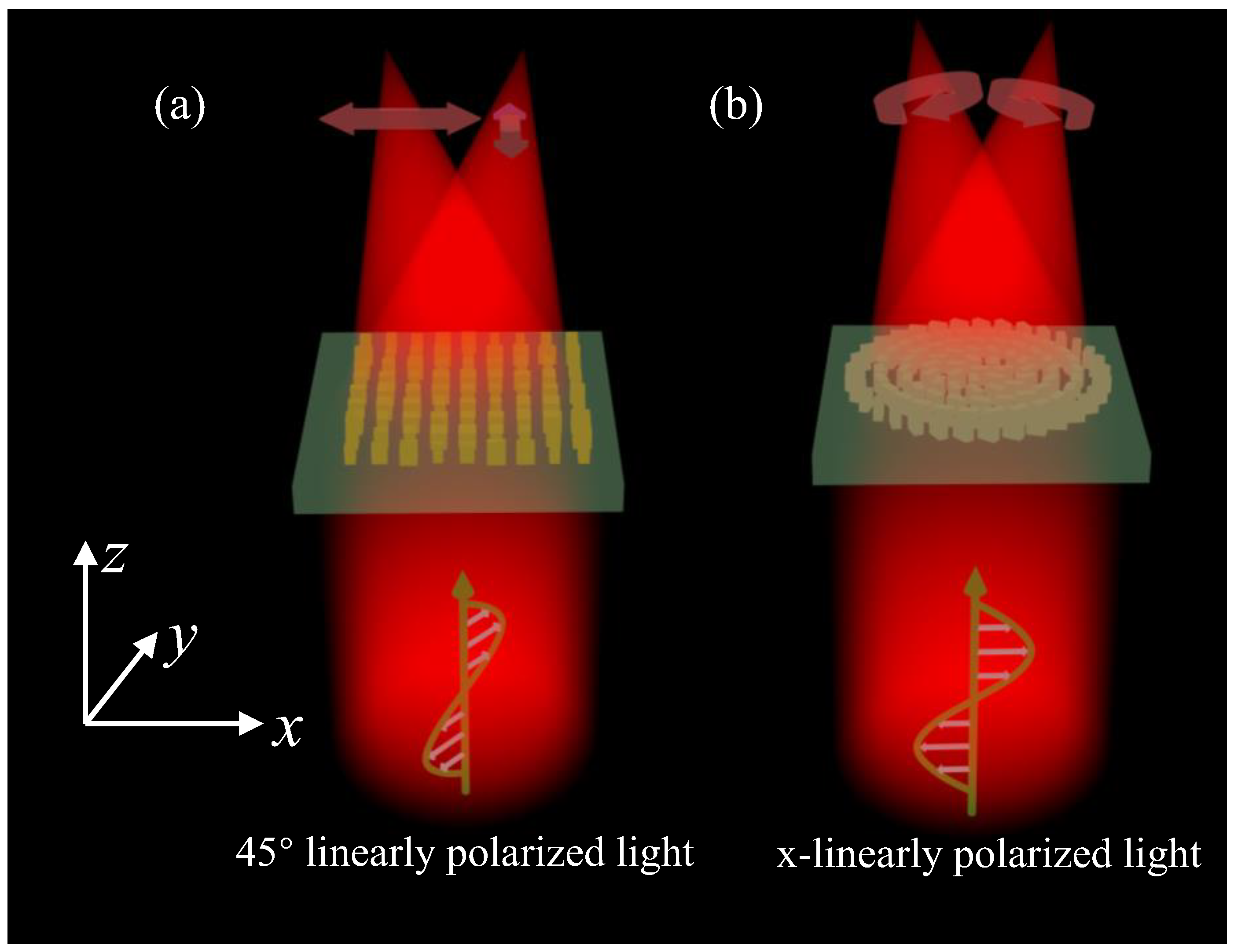
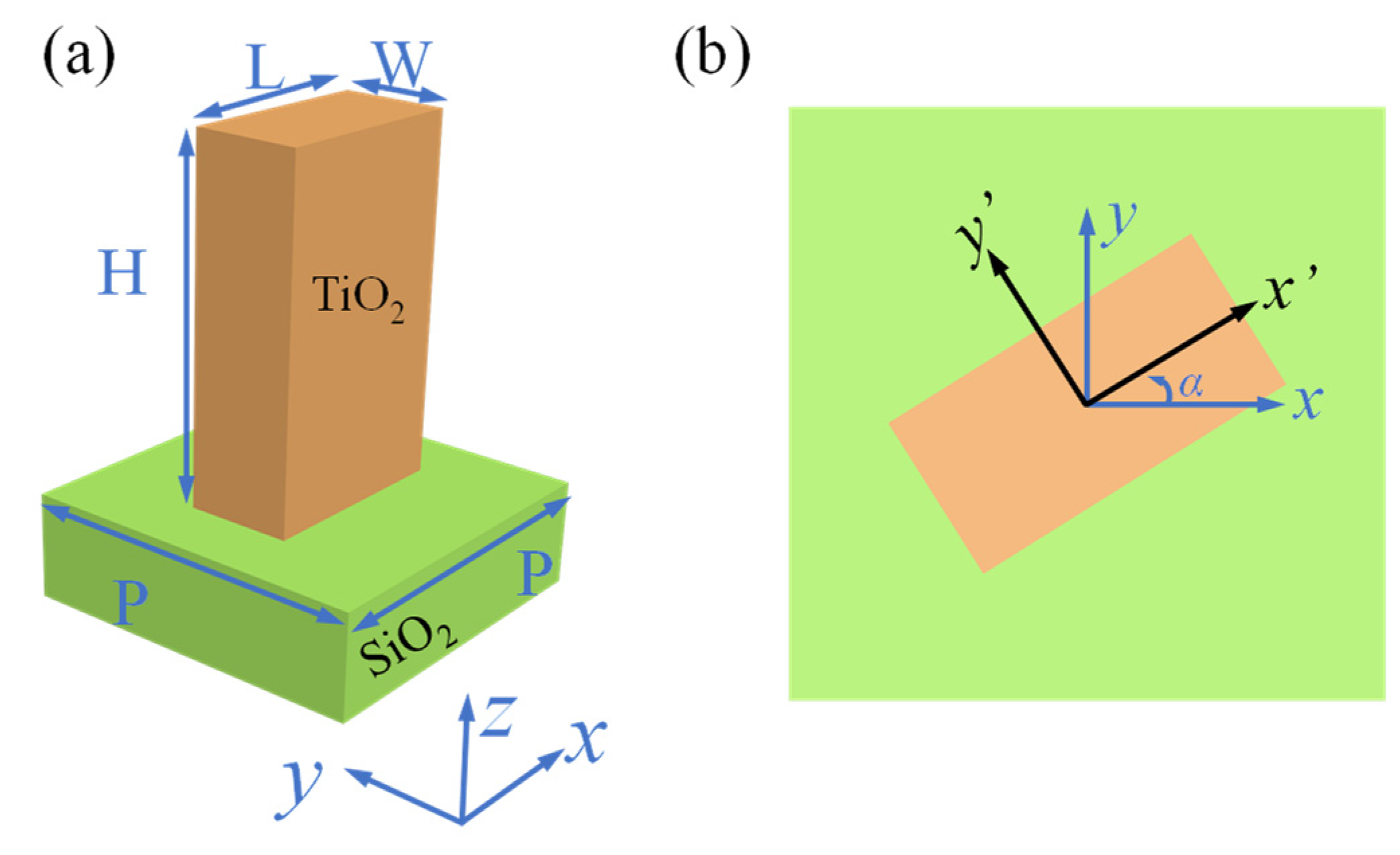
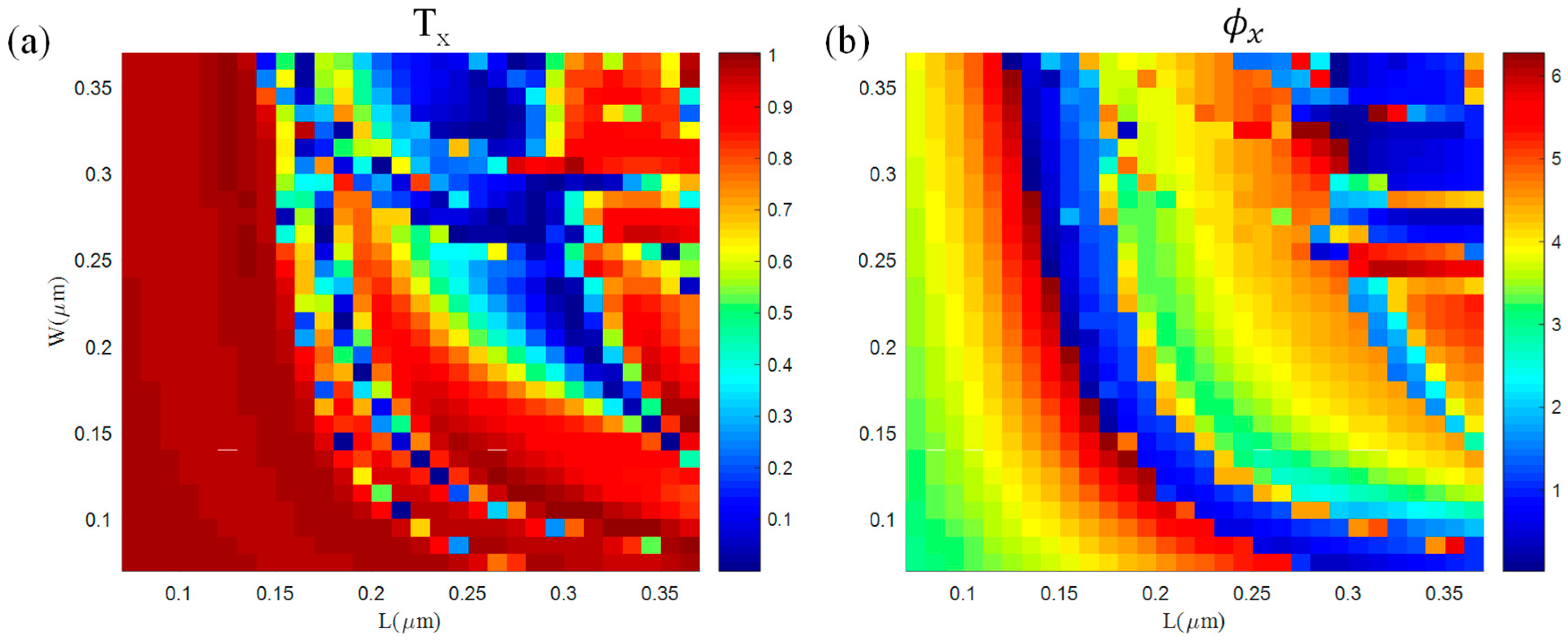
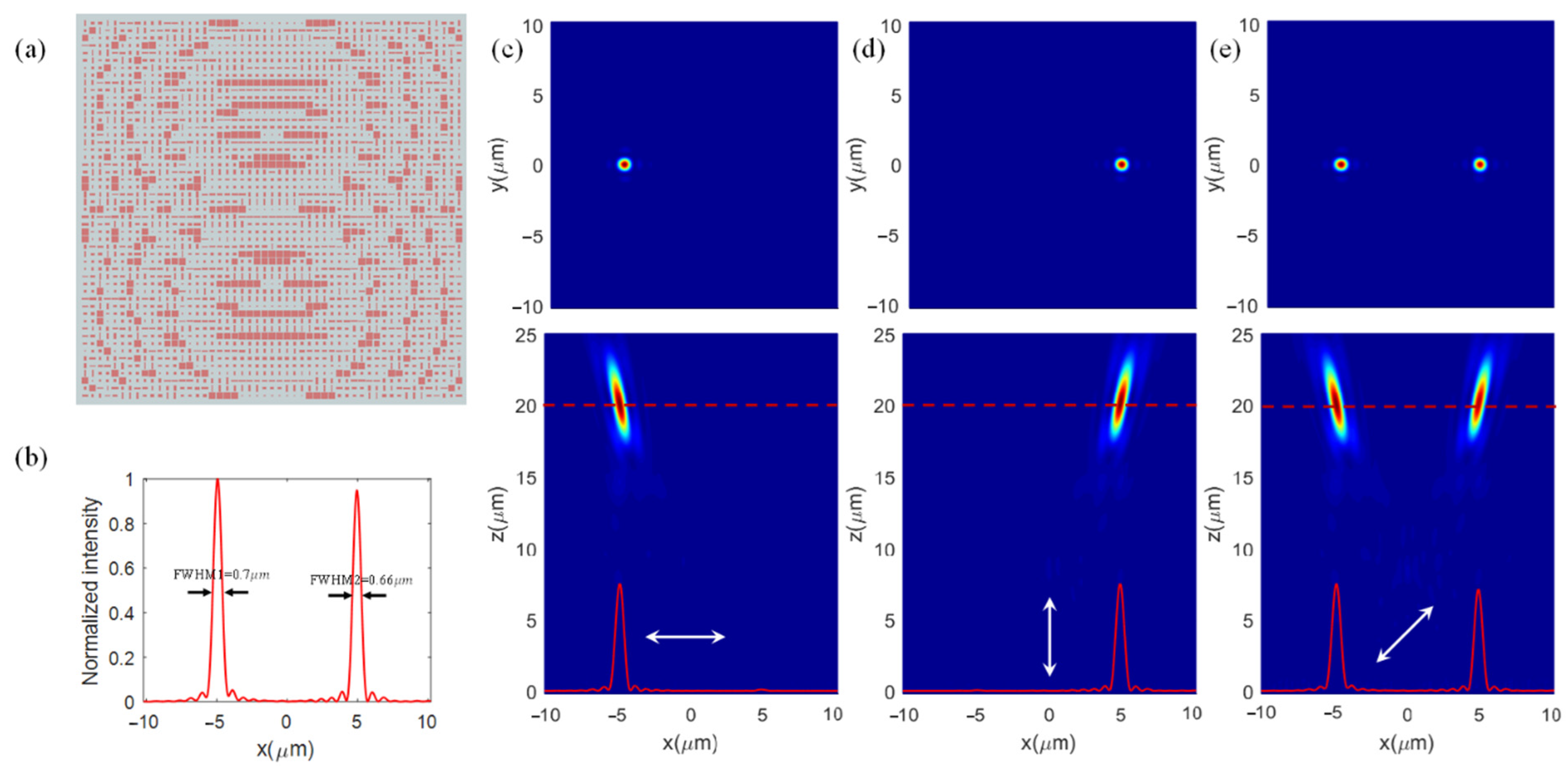
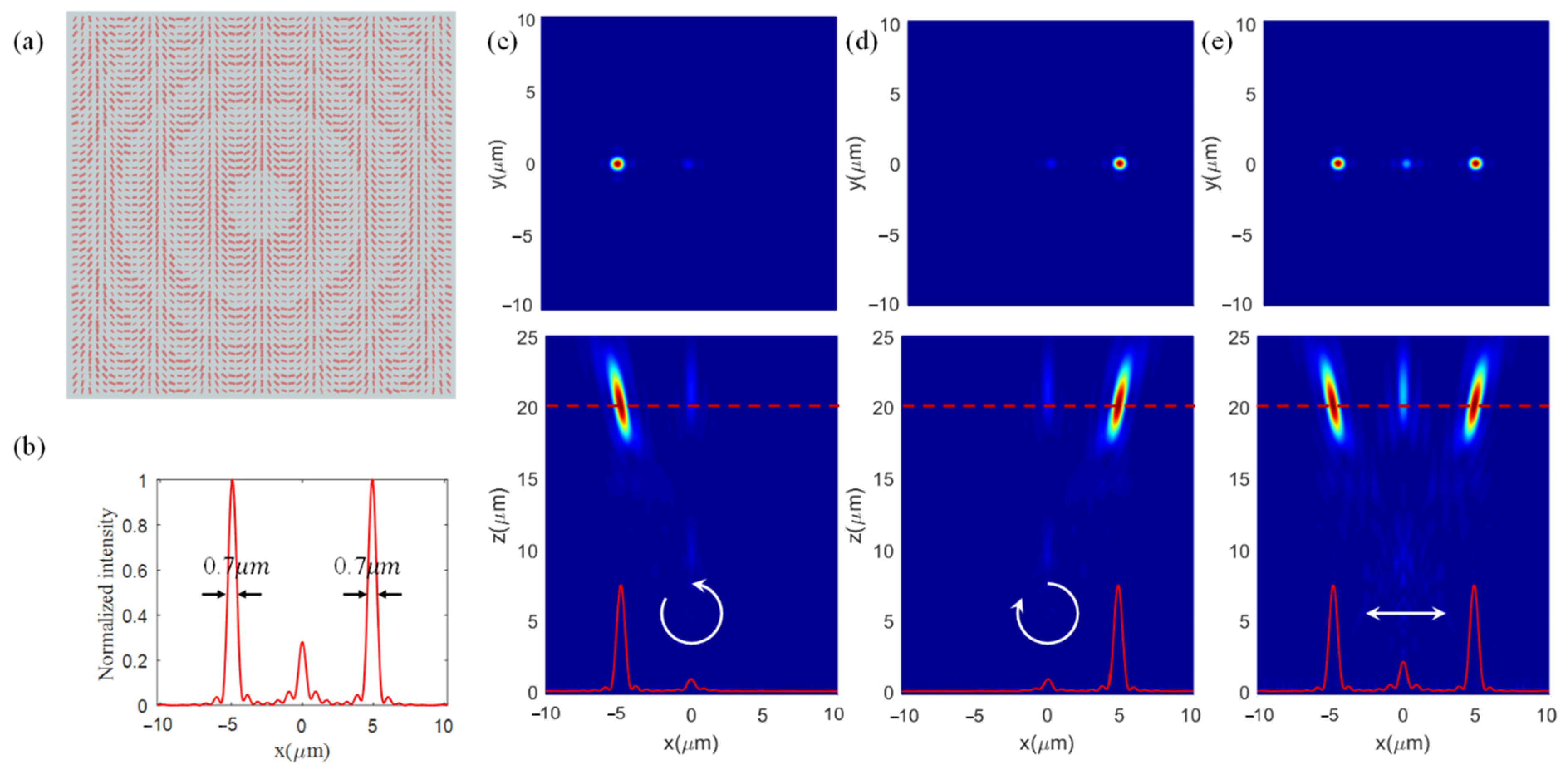
Publisher’s Note: MDPI stays neutral with regard to jurisdictional claims in published maps and institutional affiliations. |
© 2022 by the authors. Licensee MDPI, Basel, Switzerland. This article is an open access article distributed under the terms and conditions of the Creative Commons Attribution (CC BY) license (https://creativecommons.org/licenses/by/4.0/).
Share and Cite
Sun, X.; Ma, R.; Pu, X.; Ge, S.; Cheng, J.; Li, X.; Wang, Q.; Zhou, S.; Liu, W. High-Efficiency Polarization Multiplexing Metalenses. Nanomaterials 2022, 12, 1500. https://doi.org/10.3390/nano12091500
Sun X, Ma R, Pu X, Ge S, Cheng J, Li X, Wang Q, Zhou S, Liu W. High-Efficiency Polarization Multiplexing Metalenses. Nanomaterials. 2022; 12(9):1500. https://doi.org/10.3390/nano12091500
Chicago/Turabian StyleSun, Xueping, Rui Ma, Xinxin Pu, Shaobo Ge, Jin Cheng, Xiangyang Li, Quan Wang, Shun Zhou, and Weiguo Liu. 2022. "High-Efficiency Polarization Multiplexing Metalenses" Nanomaterials 12, no. 9: 1500. https://doi.org/10.3390/nano12091500
APA StyleSun, X., Ma, R., Pu, X., Ge, S., Cheng, J., Li, X., Wang, Q., Zhou, S., & Liu, W. (2022). High-Efficiency Polarization Multiplexing Metalenses. Nanomaterials, 12(9), 1500. https://doi.org/10.3390/nano12091500





